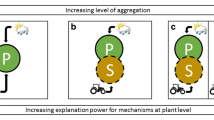Summary
The concentration, uptake and element use efficiency of N, P and K in one C3 annual (Polypogon monspeliensis) and two C4 (Echinochloa colonum, an annual, andDichathium annulatum, a perennial) grasses were determined during winter and summer seasons in monocultures raised in field plots at three moisture levels,viz. full, half and one-fourth of field capacity. At each moisture regime the plants were clipped thrice at moderate and severe levels corresponding to 40 and 80% of live green. The concentration of these elements was characteristic of the growth habit of these plants;e.g. the build up of concentration was maximum in leaf of the annuals while it was comparable in crown and leaf of Dichanthium. The N level was maximum in Polypogon. The nutrient use effiency was comparable in the two annuals and maximum K and N use were obtained in Polypogon and Dichanthium, respectively.
Similar content being viewed by others
References
Barnett N M and Naylor A W 1966 Amino acids and protein metabolism in Bermudagrass during water stress. Plant Physiol. 41, 1222–1230.
Biddulph O and Cory R 1965 Translocation of14C metabolites in the phloem of the bean plant. Plant Physiol. 40, 119–129.
Black C C, Brown R H and Moore R C 1978 Plant Photosynthesis.In Limitations and Potentials for Biological Nitrogen Fixation in the Tropics. Eds. J Dobereiner, R H Burris and A Hollaender. Plenum Press, New York, pp 95–110.
Brown R H 1978 A difference in N use efficiency in C3 and C4 plants and its implications in adaptation and evolution. Crop Sci. 18, 93–98.
Cole C V, Innis G S and Stewart J W B 1977 Simulation of phosphorus cycling in semi-arid grasslands. Ecology 58, 1–15.
Colman R L and Lazenby A 1970 Factors affecting the response of tropical and temperate grasses to fertilizer nitrogen. Proc. XI Int. Grassl. Cong., Surfers Paradise, Australia, pp 393–397.
Dove L P 1968 Nitrogen distribution in tomato plants during drought. Phyton 25, 49–52.
Gauch H G 1973 Inorganic Plant Nutrition. Dowden, Hutchinson & Sons Inc., Stroudsbrug Pennsylvania. pp 488.
Hannapel R J, Fuller W H, Bosma S and Bullock J S 1964 Phosphorus movement in calcareous soils. I. Precominance of organic forms of phosphorus movement. Soil Sci. 97, 350–357.
Humble C and Raschke K 1971 Stomatal opening quantitatively related to potassium transport. Plant Physiol. 47, 701–712.
Jackson M L 1958 Soil Chemical Analysis. Prentice Hall Inc., N.J.
Larcher W 1980 Physiological Plant Ecology. Springer Verlag, Berlin 252 p.
McKendrick J D, Owensby C D and Hydr R M 1975 Big bluestem and indian grass vegetative reproduction and annual reserve carbohydrate and nitrogen cycles. Agro-Ecosystems, 2, 75–93.
Misra G 1980 Growth characteristics of certain grasses in response to clipping and moisture stress, Ph.D. Dissertation, Banaras Hindu University, Varanasi, 564 p.
Misra G and Singh K P 1981 Total nonstructural carbohydrates of one temperature and two tropical grasses under varying clipping and soil moisture regions. Agro-Ecosystems, 7, 213–223.
Peach K and Tracey M V 1956 Modern methods of Plant Analysis. Springer Verlag, Berlin.
Reuss J O and Innis G S 1977 A grassland nitrogen flow simulation model. Ecology 58, 397–388.
Singh T N, Paleg L G and Aspinall D 1973 Stress metabolism. I. Nitrogen metabolism and growth in the barley plant during water stress. Aust. J. Biol. Sci. 26, 45–56.
Sosebee R E and Wiebe H H 1973 Effects of phenological development on radio phosphorus translocation from leaves in crested wheatgrass. Oecologia 13, 102–112.
Trlica M J and Singh J S 1979 Translocation of assimilates and creation, distribution and utilization of reserves.In Arid-land Ecosystems: Structure, Function and Management Vol. I Eds. Perry and Goodall, 1BP-16, Cambridge Univ. Press, London, pp 537–571.
Uresk D W and Sims P L 1975 Influence of grazing on crude protein content of blue grama. J. Range Manag. 28, 370–371.
Viets F G Jr 1972 Water deficits and nutrient availability.In Water deficits and Plant growth Ed. T T Kozlowski III Acad. Press London, N.Y. pp 217–240.
Wilson J R 1975 Comparative response to nitrogen deficiency of a tropical and temperate grass in the interrelation between photosynthesis, growth and the accumulation of nonstructural carbohydrate. Neth. J. Agric. Sci. 23, 1104–1120.
Woodmansee R G 1978 Additions and losses of nitrogen in grassland ecosystems. BioSci. 28, 448–453.
Author information
Authors and Affiliations
Rights and permissions
About this article
Cite this article
Misra, G., Singh, K.P. Effect of soil moisture and clipping stresses on the nutrient (N, P and K) concentration, uptake and use efficiency in one temperate and two tropical grasses. Plant Soil 69, 413–421 (1982). https://doi.org/10.1007/BF02372462
Received:
Revised:
Issue Date:
DOI: https://doi.org/10.1007/BF02372462




